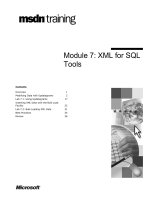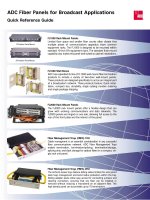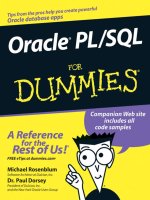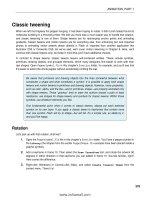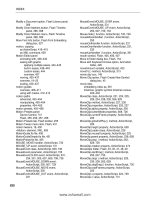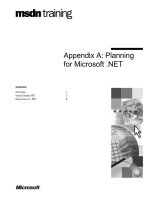Tài liệu ORACLE: BIG DATA FOR THE ENTERPRISE ppt
Bạn đang xem bản rút gọn của tài liệu. Xem và tải ngay bản đầy đủ của tài liệu tại đây (666 KB, 16 trang )
Executive Summary 2
Introduction 3
Defining Big Data 3
The Importance of Big Data 4
Building a Big Data Platform 5
Infrastructure Requirements 5
Solution Spectrum 6
Oracle’s Big Data Solution 8
Oracle Big Data Appliance 8
CDH and Cloudera Manager 9
Oracle Big Data Connectors 10
Oracle NoSQL Database 11
In-Database Analytics 12
Conclusion 14
2
Executive Summary
Today the term big data draws a lot of attention, but behind the hype there's a simple
story. For decades, companies have been making business decisions based on
transactional data stored in relational databases. Beyond that critical data, however, is a
potential treasure trove of non-traditional, less structured data: weblogs, social media,
email, sensors, and photographs that can be mined for useful information. Decreases in
the cost of both storage and compute power have made it feasible to collect this data -
which would have been thrown away only a few years ago. As a result, more and more
companies are looking to include non-traditional yet potentially very valuable data with
their traditional enterprise data in their business intelligence analysis.
To derive real business value from big data, you need the right tools to capture and
organize a wide variety of data types from different sources, and to be able to easily
analyze it within the context of all your enterprise data. Oracle offers the broadest and
most integrated portfolio of products to help you acquire and organize these diverse data
types and analyze them alongside your existing data to find new insights and capitalize
on hidden relationships.
3
Introduction
With the recent introduction of Oracle Big Data Appliance and Oracle Big Data Connectors,
Oracle is the first vendor to offer a complete and integrated solution to address the full spectrum
of enterprise big data requirements. Oracle’s big data strategy is centered on the idea that you can
evolve your current enterprise data architecture to incorporate big data and deliver business
value. By evolving your current enterprise architecture, you can leverage the proven reliability,
flexibility and performance of your Oracle systems to address your big data requirements.
Defining Big Data
Big data typically refers to the following types of data:
Traditional enterprise data – includes customer information from CRM systems,
transactional ERP data, web store transactions, general ledger data.
Machine-generated /sensor data – includes Call Detail Records (“CDR”), weblogs,
smart meters, manufacturing sensors, equipment logs (often referred to as digital
exhaust), trading systems data.
Social data – includes customer feedback streams, micro-blogging sites like Twitter,
social media platforms like Facebook
The McKinsey Global Institute estimates that data volume is growing 40% per year, and will
grow 44x between 2009 and 2020. But while it’s often the most visible parameter, volume of data
is not the only characteristic that matters. In fact, there are four key characteristics that define big
data:
Volume. Machine-generated data is produced in much larger quantities than non-
traditional data. For instance, a single jet engine can generate 10TB of data in 30
minutes. With more than 25,000 airline flights per day, the daily volume of just this
single data source runs into the Petabytes. Smart meters and heavy industrial equipment
like oil refineries and drilling rigs generate similar data volumes, compounding the
problem.
Velocity. Social media data streams – while not as massive as machine-generated data –
produce a large influx of opinions and relationships valuable to customer relationship
management. Even at 140 characters per tweet, the high velocity (or frequency) of
Twitter data ensures large volumes (over 8 TB per day).
Variety. Traditional data formats tend to be relatively well described and change slowly.
In contrast, non-traditional data formats exhibit a dizzying rate of change. As new
services are added, new sensors deployed, or new marketing campaigns executed, new
data types are needed to capture the resultant information.
4
Value. The economic value of different data varies significantly. Typically there is good
information hidden amongst a larger body of non-traditional data; the challenge is
identifying what is valuable and then transforming and extracting that data for analysis.
To make the most of big data, enterprises must evolve their IT infrastructures to handle the
rapid rate of delivery of extreme volumes of data, with varying data types, which can then be
integrated with an organization’s other enterprise data to be analyzed.
The Importance of Big Data
When big data is distilled and analyzed in combination with traditional enterprise data,
enterprises can develop a more thorough and insightful understanding of their business, which
can lead to enhanced productivity, a stronger competitive position and greater innovation – all
of which can have a significant impact on the bottom line.
For example, in the delivery of healthcare services, management of chronic or long-term
conditions is expensive. Use of in-home monitoring devices to measure vital signs, and monitor
progress is just one way that sensor data can be used to improve patient health and reduce both
office visits and hospital admittance.
Manufacturing companies deploy sensors in their products to return a stream of telemetry.
Sometimes this is used to deliver services like OnStar, that delivers communications, security and
navigation services. Perhaps more importantly, this telemetry also reveals usage patterns, failure
rates and other opportunities for product improvement that can reduce development and
assembly costs.
The proliferation of smart phones and other GPS devices offers advertisers an opportunity to
target consumers when they are in close proximity to a store, a coffee shop or a restaurant. This
opens up new revenue for service providers and offers many businesses a chance to target new
customers.
Retailers usually know who buys their products. Use of social media and web log files from their
ecommerce sites can help them understand who didn’t buy and why they chose not to,
information not available to them today. This can enable much more effective micro customer
segmentation and targeted marketing campaigns, as well as improve supply chain efficiencies.
Finally, social media sites like Facebook and LinkedIn simply wouldn’t exist without big data.
Their business model requires a personalized experience on the web, which can only be delivered
by capturing and using all the available data about a user or member.
5
Building a Big Data Platform
As with data warehousing, web stores or any IT platform, an infrastructure for big data has
unique requirements. In considering all the components of a big data platform, it is important to
remember that the end goal is to easily integrate your big data with your enterprise data to allow
you to conduct deep analytics on the combined data set.
Infrastructure Requirements
The requirements in a big data infrastructure span data acquisition, data organization and data
analysis.
The acquisition phase is one of the major changes in infrastructure from the days before big data.
Because big data refers to data streams of higher velocity and higher variety, the infrastructure
required to support the acquisition of big data must deliver low, predictable latency in both
capturing data and in executing short, simple queries; be able to handle very high transaction
volumes, often in a distributed environment; and support flexible, dynamic data structures.
NoSQL databases are frequently used to acquire and store big data. They are well suited for
dynamic data structures and are highly scalable. The data stored in a NoSQL database is typically
of a high variety because the systems are intended to simply capture all data without categorizing
and parsing the data.
For example, NoSQL databases are often used to collect and store social media data. While
customer facing applications frequently change, underlying storage structures are kept simple.
Instead of designing a schema with relationships between entities, these simple structures often
just contain a major key to identify the data point, and then a content container holding the
relevant data. This simple and dynamic structure allows changes to take place without costly
reorganizations at the storage layer.
In classical data warehousing terms, organizing data is called data integration. Because there is
such a high volume of big data, there is a tendency to organize data at its original storage
location, thus saving both time and money by not moving around large volumes of data. The
infrastructure required for organizing big data must be able to process and manipulate data in the
original storage location; support very high throughput (often in batch) to deal with large data
processing steps; and handle a large variety of data formats, from unstructured to structured.
Apache Hadoop is a new technology that allows large data volumes to be organized and
processed while keeping the data on the original data storage cluster. Hadoop Distributed File
System (HDFS) is the long-term storage system for web logs for example. These web logs are
turned into browsing behavior (sessions) by running MapReduce programs on the cluster and
6
generating aggregated results on the same cluster. These aggregated results are then loaded into a
Relational DBMS system.
Since data is not always moved during the organization phase, the analysis may also be done in a
distributed environment, where some data will stay where it was originally stored and be
transparently accessed from a data warehouse. The infrastructure required for analyzing big data
must be able to support deeper analytics such as statistical analysis and data mining, on a wider
variety of data types stored in diverse systems; scale to extreme data volumes; deliver faster
response times driven by changes in behavior; and automate decisions based on analytical
models. Most importantly, the infrastructure must be able to integrate analysis on the
combination of big data and traditional enterprise data. New insight comes not just from
analyzing new data, but from analyzing it within the context of the old to provide new
perspectives on old problems.
For example, analyzing inventory data from a smart vending machine in combination with the
events calendar for the venue in which the vending machine is located, will dictate the optimal
product mix and replenishment schedule for the vending machine.
Solution Spectrum
Many new technologies have emerged to address the IT infrastructure requirements outlined
above. At last count, there were over 120 open source key-value databases for acquiring and
storing big data, with Hadoop emerging as the primary system for organizing big data and
relational databases expanding their reach into less structured data sets to analyze big data. These
new systems have created a divided solutions spectrum comprised of:
Not Only SQL (NoSQL) solutions: developer-centric specialized systems
SQL solutions: the world typically equated with the manageability, security and trusted
nature of relational database management systems (RDBMS)
NoSQL systems are designed to capture all data without categorizing and parsing it upon entry
into the system, and therefore the data is highly varied. SQL systems, on the other hand, typically
place data in well-defined structures and impose metadata on the data captured to ensure
consistency and validate data types.
7
Figure 1 Divided solution spectrum
Distributed file systems and transaction (key-value) stores are primarily used to capture data and
are generally in line with the requirements discussed earlier in this paper. To interpret and distill
information from the data in these solutions, a programming paradigm called MapReduce is
used. MapReduce programs are custom written programs that run in parallel on the distributed
data nodes.
The key-value stores or NoSQL databases are the OLTP databases of the big data world; they
are optimized for very fast data capture and simple query patterns. NoSQL databases are able to
provide very fast performance because the data that is captured is quickly stored with a single
indentifying key rather than being interpreted and cast into a schema. By doing so, NoSQL
database can rapidly store large numbers of transactions.
However, due to the changing nature of the data in the NoSQL database, any data organization
effort requires programming to interpret the storage logic used. This, combined with the lack of
support for complex query patterns, makes it difficult for end users to distill value out of data in
a NoSQL database.
To get the most from NoSQL solutions and turn them from specialized, developer-centric
solutions into solutions for the enterprise, they must be combined with SQL solutions into a
single proven infrastructure, that meets the manageability and security requirements of today’s
enterprises.
ACQUIRE
Distributed
File Systems
DBMS
(OLTP)
ORGANIZE
MapReduce
Solutions
ETL
ANALYZE
Data
Warehouse
Key/Value
Stores
Flexible
Specialized
Developer-
centric
Trusted
Secure
Administered
8
Oracle’s Big Data Solution
Oracle is the first vendor to offer a complete and integrated solution to address the full spectrum
of enterprise big data requirements. Oracle’s big data strategy is centered on the idea that you can
evolve your current enterprise data architecture to incorporate big data and deliver business
value, leveraging the proven reliability, flexibility and performance of your Oracle systems to
address your big data requirements.
Figure 2 Oracle’s Big Data Solutions
Oracle is uniquely qualified to combine everything needed to meet the big data challenge –
including software and hardware – into one engineered system. The Oracle Big Data Appliance is
an engineered system that combines optimized hardware with the most comprehensive software
stack featuring specialized solutions developed by Oracle to deliver a complete, easy-to-deploy
solution for acquiring, organizing and loading big data into Oracle Database 11g. It is designed to
deliver extreme analytics on all data types, with enterprise-class performance, availability,
supportability and security. With Big Data Connectors, the solution is tightly integrated with
Oracle Exadata and Oracle Database, so you can analyze all your data together with extreme
performance.
Oracle Big Data Appliance
Oracle Big Data Appliance comes in a full rack configuration with 18 Sun servers for a total
storage capacity of 648TB. Every server in the rack has 2 CPUs, each with 6 cores for a total of
216 cores per full rack. Each server has 48GB
1
memory for a total of 864GB of memory per full
rack.
1
Upgradeable to 96GB or 144GB
9
Figure 3 High-level overview of software on Big Data Appliance
Oracle Big Data Appliance includes a combination of open source software and specialized
software developed by Oracle to address enterprise big data requirements.
The Oracle Big Data Appliance integrated software
2
includes:
Full distribution of Cloudera’s Distribution including Apache Hadoop (CDH)
Cloudera Manager to administer all aspects of Cloudera CDH
Open source distribution of the statistical package R for analysis of unfiltered data on
Oracle Big Data Appliance
Oracle NoSQL Database Community Edition
3
And Oracle Enterprise Linux operating system and Oracle Java VM
CDH and Cloudera Manager
Oracle Big Data Appliance contains Cloudera’s Distribution including Apache Hadoop (CDH)
and Cloudera Manager. CDH is the #1 Apache Hadoop-based distribution in commercial and
non-commercial environments. CDH consists of 100% open source Apache Hadoop plus the
2
Oracle Big Data Connectors is a separately licensed product but Big Data Appliance can be pre-
configured with Big Data Connectors
3
Oracle NoSQL Database Enterprise Edition is available for Oracle Big Data Appliance as a
separately licensed component
10
comprehensive set of open source software components needed to use Hadoop. Cloudera
Manager is an end-to-end management application for CDH. Cloudera Manager gives a cluster-
wide, real-time view of nodes and services running; provides a single, central place to enact
configuration changes across the cluster; and incorporates a full range of reporting and diagnostic
tools to help optimize cluster performance and utilization.
Oracle Big Data Connectors
Where Oracle Big Data Appliance makes it easy for organizations to acquire and organize new
types of data, Oracle Big Data Connectors enables an integrated data set for analyzing all data.
Oracle Big Data Connectors can be installed on Oracle Big Data Appliance or on a generic
Hadoop cluster.
Oracle Loader for Hadoop (OLH) enables users to use Hadoop MapReduce processing to create
optimized data sets for efficient loading and analysis in Oracle Database 11g. Unlike other
Hadoop loaders, it generates Oracle internal formats to load data faster and use less database
system resources. OLH is added as the last step in the MapReduce transformations as a separate
map – partition – reduce step. This last step uses the CPUs in the Hadoop cluster to format the
data into Oracle-understood formats, allowing for a lower CPU load on the Oracle cluster and
higher data ingest rates because the data is already formatted for Oracle Database. Once loaded,
the data is permanently available in the database providing very fast access to this data for general
database users leveraging SQL or Business Intelligence tools.
Oracle Direct Connector for Hadoop Distributed File System (HDFS) is a high speed connector
for accessing data on HDFS directly from Oracle Database. Oracle Direct Connector for HDFS
gives users the flexibility of querying data from HDFS at any time, as needed by their application.
It allows the creation of an external table in Oracle Database, enabling direct SQL access on data
stored in HDFS. The data stored in HDFS can then be queried via SQL, joined with data stored
in Oracle Database, or loaded into the Oracle Database. Access to the data on HDFS is
optimized for fast data movement and parallelized, with automatic load balancing. Data on
HDFS can be in delimited files or in Oracle data pump files created by Oracle Loader for
Hadoop.
Oracle Data Integrator Application Adapter for Hadoop simplifies data integration from Hadoop
and an Oracle Database through Oracle Data Integrator’s easy to use interface. Once the data is
accessible in the database, end users can use SQL and Oracle BI Enterprise Edition to access
data.
11
Enterprises that are already using a Hadoop solution, and don’t need an integrated offering like
Oracle Big Data Appliance, can integrate data from HDFS using Big Data Connectors as a stand-
alone software solution.
Oracle R Connector for Hadoop is an R package that provides transparent access to Hadoop and
to data stored in HDFS.
R Connector for Hadoop provides users of the open-source statistical environment R with the
ability to analyze data stored in HDFS, and to run R models at scale against large volumes of data
leveraging MapReduce processing – without requiring R users to learn yet another API or
language. End users can leverage over 3500 open source R packages to analyze data stored in
HDFS, while administrators do not need to learn R to schedule R MapReduce models in
production environments.
R Connector for Hadoop can optionally be used together with the Oracle Advanced Analytics
Option for Oracle Database. The Oracle Advanced Analytics Option enables R users to
transparently work with database resident data without having to learn SQL or database concepts
but with R computations executing directly in-database.
Oracle NoSQL Database
Oracle NoSQL Database is a distributed, highly scalable, key-value database based on Oracle
Berkeley DB. It delivers a general purpose, enterprise class key value store adding an intelligent
driver on top of distributed Berkeley DB. This intelligent driver keeps track of the underlying
storage topology, shards the data and knows where data can be placed with the lowest latency.
Unlike competitive solutions, Oracle NoSQL Database is easy to install, configure and manage,
supports a broad set of workloads, and delivers enterprise-class reliability backed by enterprise-
class Oracle support.
Figure 4 NoSQL Database Architecture
12
The primary use cases for Oracle NoSQL Database are low latency data capture and fast
querying of that data, typically by key lookup. Oracle NoSQL Database comes with an easy to
use Java API and a management framework. The product is available in both an open source
community edition and in a priced enterprise edition for large distributed data centers. The
former version is installed as part of the Big Data Appliance integrated software.
In-Database Analytics
Once data has been loaded from Oracle Big Data Appliance into Oracle Database or Oracle
Exadata, end users can use one of the following easy-to-use tools for in-database, advanced
analytics:
Oracle R Enterprise – Oracle’s version of the widely used Project R statistical
environment enables statisticians to use R on very large data sets without any
modifications to the end user experience. Examples of R usage include predicting airline
delays at a particular airports and the submission of clinical trial analysis and results.
In-Database Data Mining – the ability to create complex models and deploy these on
very large data volumes to drive predictive analytics. End-users can leverage the results
of these predictive models in their BI tools without the need to know how to build the
models. For example, regression models can be used to predict customer age based on
purchasing behavior and demographic data.
In-Database Text Mining – the ability to mine text from micro blogs, CRM system
comment fields and review sites combining Oracle Text and Oracle Data Mining. An
example of text mining is sentiment analysis based on comments. Sentiment analysis
tries to show how customers feel about certain companies, products or activities.
In-Database Semantic Analysis – the ability to create graphs and connections between
various data points and data sets. Semantic analysis creates, for example, networks of
relationships determining the value of a customer’s circle of friends. When looking at
customer churn customer value is based on the value of his network, rather than on just
the value of the customer.
In-Database Spatial – the ability to add a spatial dimension to data and show data
plotted on a map. This ability enables end users to understand geospatial relationships
and trends much more efficiently. For example, spatial data can visualize a network of
people and their geographical proximity. Customers who are in close proximity can
readily influence each other’s purchasing behavior, an opportunity which can be easily
missed if spatial visualization is left out.
In-Database MapReduce – the ability to write procedural logic and seamlessly leverage
Oracle Database parallel execution. In-database MapReduce allows data scientists to
create high-performance routines with complex logic. In-database MapReduce can be
13
exposed via SQL. Examples of leveraging in-database MapReduce are sessionization of
weblogs or organization of Call Details Records (CDRs).
Every one of the analytical components in Oracle Database is valuable. Combining these
components creates even more value to the business. Leveraging SQL or a BI Tool to expose the
results of these analytics to end users gives an organization an edge over others who do not
leverage the full potential of analytics in Oracle Database.
Connections between Oracle Big Data Appliance and Oracle Exadata are via InfiniBand,
enabling high-speed data transfer for batch or query workloads. Oracle Exadata provides
outstanding performance in hosting data warehouses and transaction processing databases.
Now that the data is in mass-consumption format, Oracle Exalytics can be used to deliver the
wealth of information to the business analyst. Oracle Exalytics is an engineered system providing
speed-of-thought data access for the business community. It is optimized to run Oracle Business
Intelligence Enterprise Edition with in-memory aggregation capabilities built into the system.
Oracle Big Data Appliance, in conjunction with Oracle Exadata Database Machine and the new
Oracle Exalytics Business Intelligence Machine, delivers everything customers need to acquire,
organize, analyze and maximize the value of Big Data within their enterprise.
Figure 5 shows three Big Data Appliances streaming data – for example leveraging Apache
Flume – from sensors and social media, acquiring this data, organizing it and leveraging Oracle
Exadata for data analysis.
Figure 5 Usage model for Big Data Appliance and Exadata
14
Conclusion
Analyzing new and diverse digital data streams can reveal new sources of economic value,
provide fresh insights into customer behavior and identify market trends early on. But this influx
of new data creates challenges for IT departments. To derive real business value from big data,
you need the right tools to capture and organize a wide variety of data types from different
sources, and to be able to easily analyze it within the context of all your enterprise data. By using
the Oracle Big Data Appliance and Oracle Big Data Connectors in conjunction with Oracle
Exadata, enterprises can acquire, organize and analyze all their enterprise data – including
structured and unstructured – to make the most informed decisions.
